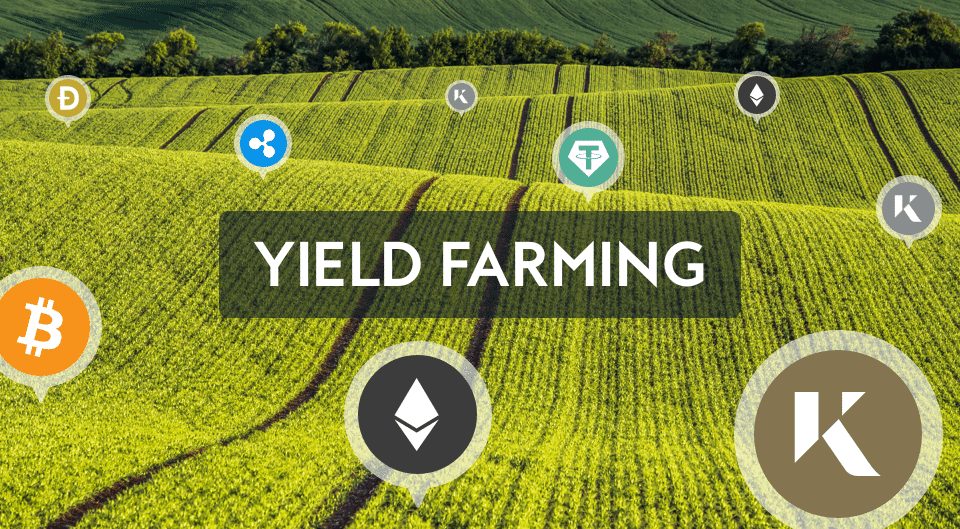What Is Yield Farming?
Yield farming, also known as liquidity farming, is the practice of lending or staking your cryptocurrency into a liquidity pool using DeFi (Decentralized Finance) in exchange for interest and more of their staked cryptocurrency. It’s the equivalent of lending fiat money to a bank, similar to traditional staking.
The annual return rate of an asset, including compounding, is commonly measured as APY, which is the annual return rate of an asset. The bigger the gap between an investment’s APY and APR, the more frequently interest compounds. Banks and other traditional investments often have a fixed APR.
Yield farming is frequently compared to Silicon Valley businesses like Uber, which provide attractive incentives to early investors. To help support and eventually develop the platform, new blockchain apps require liquidity, which is where yield farming comes in.
All yield-farming-staked cryptocurrency is pooled into a liquidity pool, which is usually for a specific pair of cryptocurrencies, such as CRO/ETH. Instead of using the general buyers and sellers method, these liquidity pools could be run by Automatic Market Makers, who enable automatic and permissionless trading by tapping into liquidity pools.
How Does It Work?
An investor stakes their bitcoin coins via a dApp’s ‘loan protocol’ (decentralized app on DeFi). Now that their liquidity is in, other investors can borrow it to use in their own bets, hoping to profit from huge price swings in the staked coins.
Because yield farming is utilized to reward early investors, governance tokens for that blockchain are frequently distributed in order to keep them as users and maintain their liquidity in the system. Governance tokens aid in the decentralization of a project by allowing real users to vote on new legislation. Any DAO or project that wants to be completely run by its people needs governance tokens.
Liquidity pools effectively keep the ecosystem alive, and they are where the majority of the early liquidity in smaller enterprises will come from.
What Are the Possible Benefits?
Yield Farming was launched in 2020, and several yield farmers have boasted about triple-digit APY rates, which are unheard of outside of the crypto world. These rates, on the other hand, bring with them a high level of volatility. The tokens received as incentives from such farms are frequently exceedingly volatile and susceptible to rug pulls. Later in the text, we’ll go through the dangers of yield farming in further detail.
A complete list of the most popular and profitable yield farms, including with daily and yearly APY, can be found here. CoinMarketCap only considers this as a resource, and investors are advised to conduct their own due diligence before entering the risky realm of yield farming.
Many yield farms with little temporary loss risk are still paying double-digit annual APYs, with specialty coin combinations and riskier farms paying triple and even quadruple-digit APYs, which are unsustainable but profitable in the short term.
Even while practically all crypto trading is speculation, high-level tactics are frequently required to continuously earn from yield farming, and a substantial sum of money is often advised, even for beginners.
Mining for Liquidity
A yield farmer will often receive interest based on the APY for their stake. Liquidity mining, on the other hand, occurs when the farmer receives a new token in addition to their existing interest as a thank you for participating.
Yield Farming’s Risks
Yield farming, like anything else in a totally speculative market like cryptocurrency, necessitates a larger risk tolerance than usual. Yield-farming is only possible on Decentralized Exchanges (DEX), which opens up a slew of hazards.
Pulls for Rugs
Rug pulls occur when a cryptocurrency’s developers or founders decide to abandon a project, usually without warning, by withdrawing the project’s liquidity financed by investors. Investors maintain their coins, but they are no longer valuable.
The founders have no intention of returning to the project, thus a rug pull is an exit scam. Because of the type of startup cryptocurrency ventures they are investing in, as well as the intrinsic anonymity of crypto, yield farmers are more vulnerable to exit scams than the general public.
Bugs or Hacks in Smart Contracts
Smart contract risk is the greatest visible danger in yield farming, and it happens when faults make the farmer’s funds vulnerable to being hacked or stolen.
Temporary loss
During the stake, the farmer’s coins follow the market value of that coin, which means that an investor might theoretically lose a lot more than the interest paid if the value of their staked crypto decreases dramatically.
However, it may be claimed that the farmer would not have sold if they hadn’t staked their coins, so at the very least they had piqued their curiosity.
Volatility
Dealing with extremely volatile cryptos can imply a skyrocket or plummet while your crypto is locked in a stake, and there’s nothing you can do about it until the coins are freed, on the same note as impermanent loss.
What Are the Best Yield Farming Platforms?
Any well-known decentralized exchange that supports dApps is the typical go-to platform for yield farming. Here are some good examples:
Pancake swap Uniswap
Sushiswap 1inch Network Sushiswap 1 Please keep in mind that DeFi has a considerably steeper learning curve for new users than centralized exchanges, and that mistakes can be costly! Before you jump into any of these platforms, do your homework!
Network of 1 inch
The 1inch network is a great place for beginners to start their yield farming journey because it pools the best rates and pools from all over the crypto-sphere, which means you won’t have to manually hop around several different decentralized exchanges or dApps to find the best pools to provide liquidity.
1inch gives a basic guide on how to get started with yield farming. It can be found here.
There is no ‘best’ platform for yield farming, in my opinion. Each platform will allow yield farmers to work on different chains, so do your study before deciding.
The parts will fall into place more smoothly and with less danger if you have a clear strategy before you begin.
Is Yield Farming a Good Investment?
You must not only have a good strategy in place to maximize your yield and the initial funds to invest to be genuinely effective at yield farming, but you must also be passionate about actively earning passive income.
Although you can just stake in safe pools, the goal of yield farming is to maximize your profits.
What do you want? That is the most important question to ask when evaluating whether yield farming is worth it to you. Yield farming, especially on networks like Ethereum with high gas rates, is only feasible for people wanting to deposit a significant quantity; otherwise, gas fees will eat up your initial investment.
If you don’t want to spend a lot of time learning methods and discovering the finest pools, you could want to start with simple staking and understanding the basics before moving on to become a yield farmer.



